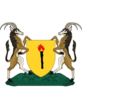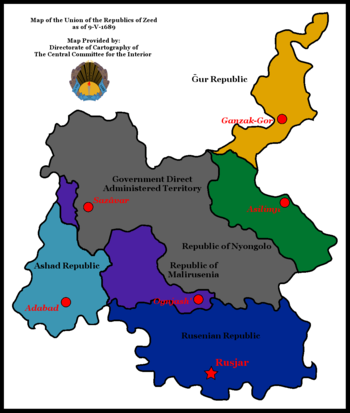Zeed/Alt Article
The Union of the Republics of Zeed, or more often simply as Zeed, is located in south-western region of the continent of Eura. A multi-ethnic state, Zeed was founded out of the remnants of the Empire of Zeed - itself the product of an ethnic conglomeration of many of the former peoples of Babkha and the post-nuclear horror, nominally headed by the Ruthenian ethnic group. Following The September Revolution, Zeed was transformed into a federative Union of relatively autonomous republics, each one largely comprising of a separate ethnic group or similarly related groups facilitating their need for such an autonomous region within the Union. Incredibly diverse in history and ethnicity, Zeed is a microcosm of the ancient realms which once inhabited its parent continent, leading to the necessity of the unique form of democracy the people enjoy today.
Etymology
In centuries past, the Ruthenian people and their lands were largely referred to as Seyyedi - roughly translating as "distinguished peoples" in colloquial Babki by the various Babkhan tribes. A noted Osmanid Khan and explorer, Arshahma al-Osmani Khan, noted in his diaries -
Their complexion was of a bit fairer tones than our own, with no uniform hue of hair - brown, blonde and even black hued hair could be seen among every strata of their society. All were well-groomed, their long locks of hair clean and perfumed, as was their skin. I can only attribute this to their almost religious use of bath houses - what they refer to as banya. The fabrics in which they clothed themselves in were plain, but they belied craftsmanship worthy of a Shah. It is this craftsmanship that I have sought such interactions with these tribes. They are uniquely distinguished among the barbarians of these open lands.—Diaries of Arshahma al-Osmani Khan, Undated
However, through the centuries and Babkhan expansion throughout Eura, Ruthenians saw themselves slowly integrated into the Harmonious Society at varying levels. This eventually lead to a concept of those with Ruthenian ethnic backgrounds being known as Seyyedic people in the more archaic Babki dialects. This eventually saw the use of the ethnonym Zeedic come into common use in the modern tongues. With so much of Babkhan cultural an linguistic influences still being very much present in the Union's predecessor state - The Empire of Zeed - it was natural to the use Zeed as a concept of the people and the nationhood.
Constituent Republics
The constituent Republics of the Union are what make of the primary subdivisions of the nation. Each one is an ethnic, linguistic, or historical region - solidified into a largely self-governing province. Each Republic is granted a seat in The All-Union Presidium of the Republics, the legislative body of the Union. This comprises the representation of the uniquely diverse population of the nation to the national government under the concept of self-governance uniquely suited to the constituent people, unifying and working together towards the common good of the nation - one of the core tenants of the Union.
| Official Name (Common Language) | Official Banner | Official Seal |
| Ashad Republic | 
|

|
| Ḡur Republic | 
|
File:Ḡur CoA.png |
| Ruthenian Republic | 
|
-125px |
| Republic of Nyongolo | 
|

|
Each republic governs themselves in accordance with their own constitution or set of by-laws. The Constitution of the Union specifically reserves nineteen powers for the national government. No such constituency may pass any law which pertains to those reserved powers or attempt to exercise them.
Article 2 - The sovereignty of the republics is limited only within the provisions set forth in this Constitution. Outside of these provisions, each republic exercises state authority independently.
Coupled with the general policy of "ethnic and regional autonomy" as practiced by First Secretary Timoshenko, while it is a cohesive nation united under common principles, the general atmosphere and governance of each republic is nearly identical to an independent nation. There are approximately 19 powers which the national government reserves the right to exercise, all of which deal with foreign relations and trade, national security and internal economics. This is very evident when looking at the Ḡur Republic, as their own internal factions have struggled with conflicts long since before the Union. However, as they are largely part of the concept of ethnic and regional autonomy - and the fact that these small scale skirmishes do not directly effect national security - they are ignored.
